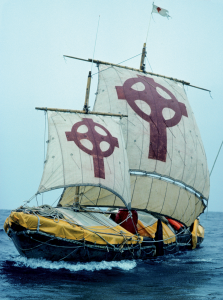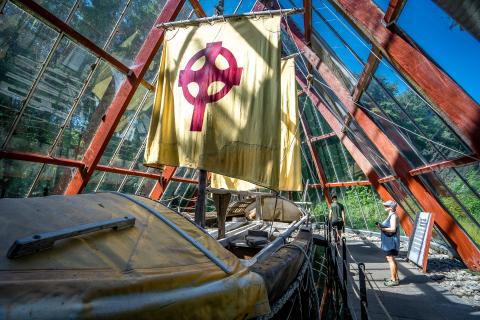[1] Post haec, acceptā benedictiōne sānctī patris et omnium monachōrum quī cum eō erant, profectus est in ultimam partem regiōnis suae, ubi dēmorābantur parentēs eius. [2] Attamen nōluit illōs vidēre, sed in cuiusdam summitāte montis extendentis sē longē in ōceanum, in locō quī dīcitur Sēdēs Brendānī, fīxit tentōrium, ubi erat introitus ūnīus nāvis.
[3] Sānctus Brendānus et quī cum eō erant, acceptīs ferrāmentīs, fēcērunt ūnam nāviculam levissimam, costātam et columnātam ex īvō, sīcut mōs est in illīs partibus, et cooperuērunt illam coriīs bovīnīs atque rubrīcātīs in cortice roborīnō.
[4] Et liniērunt forās omnēs iūnctūrās pellium ex būtīrō; et mīsērunt duās aliās parātūrās nāvis dē aliīs coriīs intus in nāvim, et dispendia quadrāgintā diērum, et būtīrum ad pellēs praeparandās ad cooperimentum nāvis, et cētera ūtēnsilia, quae ad ūsum vītae hūmānae pertinent. [5] Arborem posuērunt in mediō nāvis fīxam, et vēlum, et cētera quae ad gubernatiōnem nāvis pertinent. [6] Sānctus Brendānus frātribus suīs praecēpit, in nōmine Patris et Fīliī et Spīritūs Sānctī, intrāre in nāvim.
notes
Brendan and his companions travel to the land of his birth, in what is now County Kerry, in southwest Ireland. There they build a currach, a traditional Irish boat made with a light wooden frame and ox hides.
[1] in ultimam partem regiōnis suae: Brendan’s general regio was Munster (roughly the southwestern quarter of Ireland), and his family home in Kerry was in the extreme southwest.
[2] nōluit illōs vidēre: as at 2.5, there was tension between family and monastic obligations.
Sēdēs Brendānī: now called “Brandon Head” or “Mount Brandon,” on the Dingle penninsula, County Kerry.
ubi erat introitus ūnīus nāvis: i.e., an inlet narrowing to the minimum width and depth for a single boat; the spot is thought to be “Brandon’s Creek” on the north coast of the Dingle Peninsula. They find other such narrow harbors on the voyage (6.11; 11.5; 12.6); the implication is that they were ordained as special places for Brendan’s boat.
[3] fēcērunt ūnam nāviculam levissimam: they constructed a traditional Irish skin-boat, called a currach. The description is taken to be accurate, though the language is also reminiscent of the description of the Hebrew Tabernacle, Exodus 39.33–34: “Then they brought the tabernacle to Moses, the tent, and all its utensils, its hooks, its frames, its pillars (columnas), and its bases. (34) the covering of tanned rams’ skins (pellibus ... rubricatis) and the covering (operimentum) of fine leather, and the curtain (velum) of the screen.”
costātam et columnātam: the ribs and horizontal cross-pieces that hold the hides in place.
ex īvō: CL would be īvō (ablative of source and material).
in illīs partibus: either western Ireland generally or Kerry in particular.
coriīs bovīnīs atque rubrīcātīs in cortice ruborīnō: “with hides made from oxen and tanned with (liquid made from) the bark of oak trees.” CL would be cortice ruborīnō (ablative of material).
[4] ex būtīrō: presumably animal fat rather than butter, used to make the joints water resistant; CL would be būtīrō (ablative of source or material).
mīsērunt: “they sent in” means “they placed in.”
duās aliās parātūrās nāvis dē aliīs coriīs: “two other preparations for the ship made from other hides,” i.e., materials for building two other boats. Either they were planning to build extra boats on the voyage or (more likely) they put in enough spare hides to recover the ship twice.
vocabulary
| benedictiō –ōnis f. | a blessing 1 |
| monachus –ī m. | a monk |
| regiō regiōnis f. | region; direction, line |
| dēmoror –ātus sum | to linger, delay, stay |
| attamen | nevertheless, however (at + tamen) 2 |
| summitas –ātis f. | top; surface [OLD 2] |
| extendō –ere –tendī –tentus (–tēnsus) |
to stretch forth; stretch |
| ōceanus –ī m. | the ocean |
| fīgō fīgere fīxī fīxus | to drive in, plant, fasten |
| tentōrium –iī n. | tent |
| introitus –ūs m. | entrance |
| ferrāmentum –ī n. | an implement or tool of iron 3 |
| faciō facere fēcī factus | to do, make; to act, conduct oneself [OLD 28] |
| nāvicula –ae f. | boat (ML); (CL) small boat |
| costātus –a –um | ribbed |
| columnātus –a –um | provided with pillars |
| īvum –ī n. | yew (ML) |
| co-operiō –operīre –operuī –opertum |
to cover over |
| corium –ī n. | skin, hide |
| bovīnus –a –um | pertaining to oxen or cows (LL) |
| rubrīcō –āre | to redden (ML) |
| cortex –icis m. | bark |
| roborīnus –a –um | oak, of oak (ML) |
| līniō –īre –īvī (–iī) –ītum | smear |
| forās | outside, on the outside 4 |
| iūnctūra –ae f. | joint |
| pellis pellis f. | skin, hide |
| būtȳrum –ī n. | butter (ML; CL būtȳrum or būtīrum –ī n.) |
| mittō mittere mīsī missus | to send, let go; to thrust; to put [OLD 13] |
| corium –ī n. | skin, hide |
| intus | within, inside |
| dispendium –ī n. | provisions, food supplies (ML; CL dispendium –(i)ī n.: expenditure) |
| quādrāginta; quādrāgesimus –a –um |
40; 40th |
| būtȳrum –ī n. | butter (ML; CL būtȳrum or būtīrum –ī n.) |
| pellis pellis f. | skin, hide |
| praeparō –parāre –parāvī –parātus |
to prepare, make preparations |
| cooperimentum –ī n. | covering |
| ūtēnsilia –ium n. | things for use, materials, supplies, provisions |
| fīgō fīgere fīxī fīxus | to drive in, plant, fasten |
| vēlum vēlī n. | sail; curtain; cloth 5 |
| gubernātio –ōnis f. | steering |



